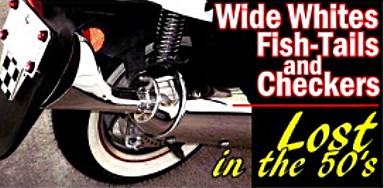Post by oldchopperguy on Mar 28, 2016 22:25:32 GMT -5
Well, boyz and gurlz...
I have gotten back to installing LED driving lights on Minnie Mouse, and learned a few things to pass on to others wanting to brighten up the road...
FIRST, there's HARDLY a "flat" piece of plastic on the noses of these... So... when mounting to plastic, you really need to provide for spreading the stress. I chose to use a motorcycle-style "light-bar" mounted under the mouse's nose. I used pieces of rubber radiator-hose as "biscuits" along with U-bolts, and this seems to work fine. I used double nuts on the U-bolts rather than lock-washers to avoid over-tightening and stressing the plastic. The bar is rock-solid and cushioned, spreading the load across the "wavy" plastic. See kitchen-table pix below... LOL!
The light-bar was "harvested" from my favorite source... Wally World? Nope! The trailer-park DUMPSTER! It's a piece of hard-aluminum tent-pole from a discarded tent. Super-strong and only 6 ounces!!! It was buggered up, but a quick spin in a drill against a "green-pad" and it looks like a brand-new "factory" part.
Those GREEN PADS are AMAZING! 
It's 3/4" O.D. and allows spacers, made again from radiator-hose for a cushioned, shock-resistant mounting of the lights' 1-inch I.D. mounts.
The SECOND thing I learned is that even these relatively low-draw 15W (30W equivalent) LED's DO draw some serious juice. To test my wiring setup prior to buttoning the nose back up, I used a 2-LED light that I had on-hand, equivalent to the pair of LED's I'm installing.
They draw a fairly hefty just shy of 3 amps according to my vintage battery charger, used for power. So, indeed a relay should be used in my opinion; not just a switch. And I wouldn't want to run the lights when not needed, to save the battery and charging system.
I'm used to old Hogs with automotive batteries than can handle unlimited numbers of driving and/or decorative lights, but these scooters use fairly small batteries in comparison.
To simplify the setup, I bought an LED accessory wiring harness off eBay which I believe simplifies things and saves money. It includes wiring, fuse & holder, relay (with switch and pilot-lights) and wiring harness for two lights. It's well-made and quite complete... See pix below for my kitchen-table test hookup. At less then ten-bucks it's an economical setup.
I just GOTTA give a pat on the back to my trusty battery-charger... Bought in 1955 to maintain the battery in my Dad's '55 Chevy, then used on "Old Blue" my Harley chopper w/6v system. Then, used on all our cars from around 1960 to 1980 in sub-zero Chicago winters... Then, on all my cars here in Texas since then, as well as the old Chinese 150 (haven't needed it on the Kymco yet!) and I also use it for color-anodizing aluminum, and for any and all 12v testing needed... They just do NOT make stuff to last like that anymore...
Since the on-off switch is illuminated, it needs to be powered off an "ignition-on" source. I'll simply use the running-lights wire in the nose. This also ensures the auxiliary LED's only can be lit when the ignition is on.
These LED wiring harnesses are a pretty nice way to power auxiliary lights, and I think they are cheaper than purchasing wire, switch, fuse-holder/fuse and relay, and all the goodies are factory-assembled. To simplify things, I ran a 12ga red hot-wire directly from the battery up front to the nose (run inside an automotive flexible plastic conduit to protect the hot-wire from abrasion and heat). This will connect to the fused, main hot-wire in the wiring kit.
I'll be putting the whole thing back together soon, and will post more pix on the setup. This actually turned into a bigger project than I first planned on, but with the current-draw of these lights it pays to "do it right" maybe even with a little "over-kill" to be on the safe side.
More to come... Gotta keep at it... The missus is "strongly encouraging" me to "get that scooter stuff OFF the kitchen table, OUT of the living room and BACK on the scooter"

Ride safe!
Leo in Texas











